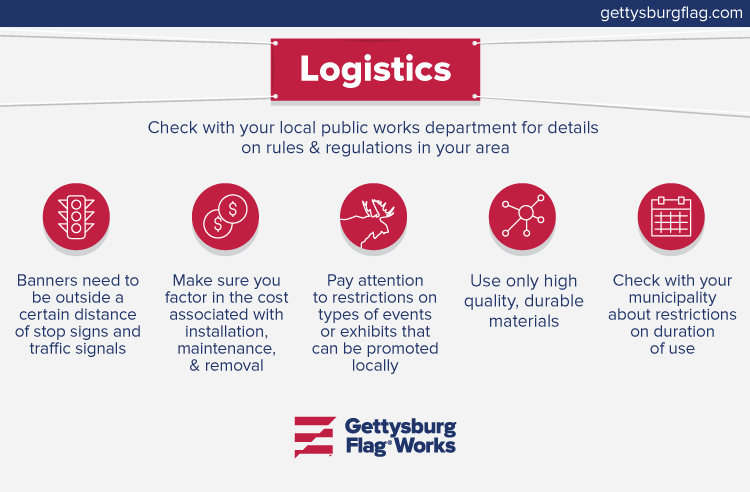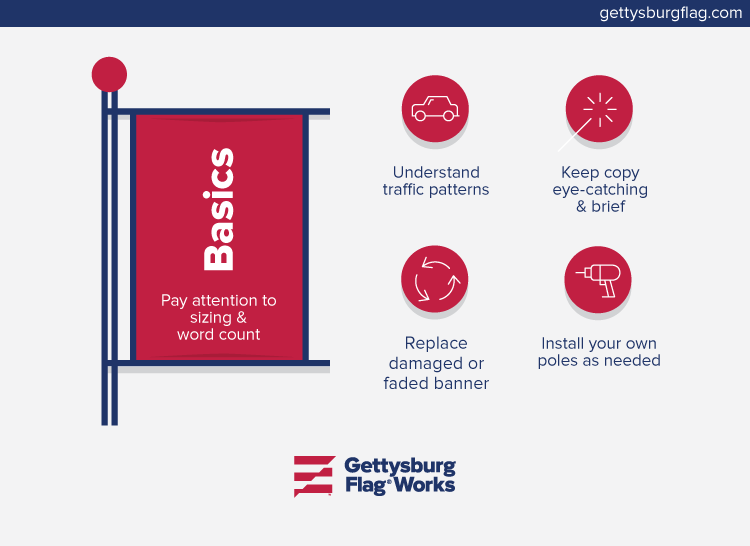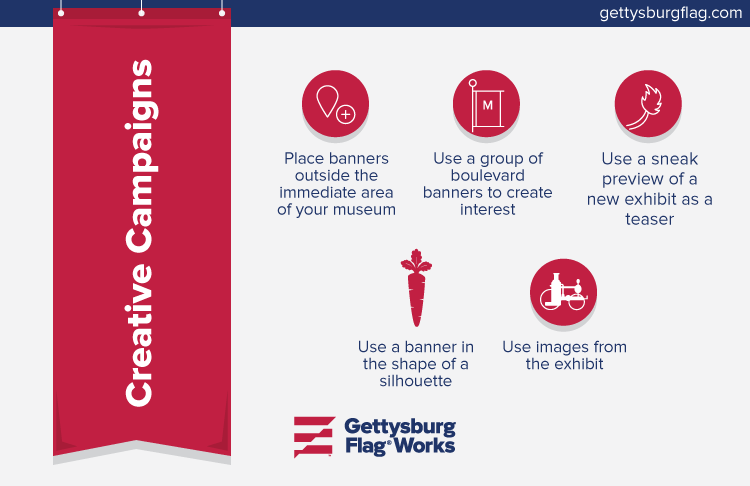How to Advertise Your Museum with Flags and Banners
About 40 million Americans travel 1.7 trillion miles by car every year. In addition to that, 19% move to a new city annually. Add that up and it’s a lot of people moving through unfamiliar territory. The proper use of flags and banners can go a long way toward letting passers by know what you have to offer. Over its lifetime, a well-placed banner can receive hundreds of thousands of impressions and reinforce your organization’s place in the community.
While investing in physical flags and banners might seem antiquated in the digital age, there are a lot of reasons that investing in outdoor advertising still works and is worth your investment:
- Cost-effectiveness: the cost per thousand is much lower for signage than for any other type of advertising (radio, TV, or newspaper).
- Visibility: with flags and banners the exposure is 24 hours a day, 365 days a year, and the average American spends 20 hours a week driving.
- Ownership: flags or banners used for advertising are owned by the business, and can be used for long periods of time or used in different places, etc. Flags and banners are not a throwaway, one-time ad.
If you operate a museum or similar sightseeing attraction, you should consider using banners and flags to attract potential patrons as they go speeding by. So whether you’re looking to increase general awareness, or provide directions for people already heading your way, we’ve compiled a list of useful tips and strategies to help you determine where and how to use custom banners and flags.
Advertising with flags and banners logistics

Signs and banners are not just for marking the location of your facility they should be for marketing as well. So make sure they are beautiful, colorful, and that they present passersby with visual cues about what to expect. However, before you finalize that amazing design, you’ll need to settle questions about effective placement.
Understand your local rules and regulations before you start planning how you will use flags and banners. Many municipalities are onboard with the idea of a street lined with beautiful banners, but when you are competing for a driver’s attention there are rules to follow. Some examples you may encounter are:
- No banners within a certain distance of a stop sign or traffic signal device.
- As the sponsor of the banners, you will likely be responsible for all costs associated with the installation, maintenance, and removal.
- Some areas only allow banners that promote a public event or cultural exhibits. Business improvement districts and local development corporations are usually allowed to install banners that promote the areas. For example New York City’s banner and sign regulations have many restrictions on locations of signs.
Once you’ve successfully negotiated all the local regulations, you can use flags and banners to compensate for a less than ideal location or to draw attention to the best features of your establishment. If your facility or attraction isn’t positioned on a well-travelled road, flags and banners can direct the flow of traffic right to your door.
Banner marketing basics

The key to successful outdoor marketing is in understanding the basics of traffic, visibility, and novelty. When thinking about traffic, you’ll want to understand traffic patterns. You can obtain all kinds of information from your city’s traffic engineer, and use this information to inform the positioning of your onsite flags and to determine the best targets for any off-site options.
Keep in mind that for drivers, signs/flags should be eye-catching and brief. They will need to make a quick decision to stop if this is an impulse, so make sure your flag is able to grab their attention. With that in mind, banner content (sizing and word count) should be informed by how fast drivers/passengers are moving and how close they are. A competent sign/flag/banner company can help you with this.
Given where you are looking to hang a flag, installing your own poles may be necessary. If you use flagpoles, you can alternate between using vertical banners as signage and using season/holiday appropriate flags.
Remember to replace damaged or faded banners immediately. Keep a number of extras on hand, depending on how often the content needs to change, but don’t leave potential patrons wondering if a tattered banner means your business is no longer open.
Creative banner use

Beyond the basics of hanging a flag or banner to advertise your attraction, there are a number of creative campaigns you could launch to draw additional attention, or advertise a special event.
- Plant your flag and claim your territory: use flags to indicate that an adjacent property is yours and available for use, such as parking or outdoor dining. Colorful and unique light pole banners in your parking lot can enhance the visitor’s experience and help them remember where they parked.
- If your building is in a great location, but a little on the plain side, use banners and flags to make your facility more unique and easily identifiable. For example, if you operate a museum, visitors should encounter a variety of banners that incorporate images from the exhibits.
Or if your attraction has something you might consider a signature exhibit, consider using banners in the shape of the well-known item. The silhouette alone will communicate your message before the visitor is even close enough to read the text.
To strengthen your business’s pull beyond your property, you’ll need to go off-site with your flags and banners. If regulations permit, place them around corners from your location to create awareness and expand your line-of-sight impact. This is a great place to use those silhouette banners that work well at a distance.
- If one doesn’t exist, form a business improvement district or other organization of neighboring businesses. As part of the organization, you may be able to place flags/banners in better off-site locations. And don’t forget to plan according to the traffic information you received from the city engineer.
- If you have a big event on the way, you might want to go big and consider an avenue banner. Historical areas or business districts usually accommodate this type of signage best, and you will always want to seek approval prior to hanging the banner. But the red tape will be worth it, because is there anything more all-American than a banner stretched across Main Street?
- If you are promoting an event at your organization (for example an exhibition at your museum) contact your local town hall and discuss the possibilities of locating them near your location or on a busier street. If your event or attraction could bring people and business to the area they might be open to putting up your flags.
- Not sure where to begin? An “Open” flag, and one or two well-placed “Feather flags” will go along way to draw attention to a building. Gettysburg Flag Works has a list of featured business flags that would be a huge help in advertising any museum or attraction.Signs and banners are an important part of marketing any museum or tourist attraction. With a little planning and research, you can use flags and banners to enhance your visitors’ experience, increase your visibility, and attract new patrons. Ready to get started? Take a look at our selection of custom flags and banners
